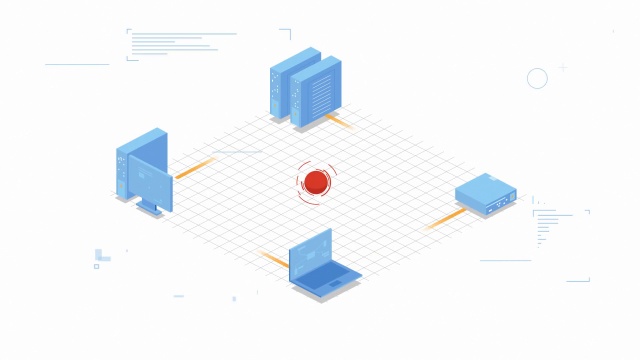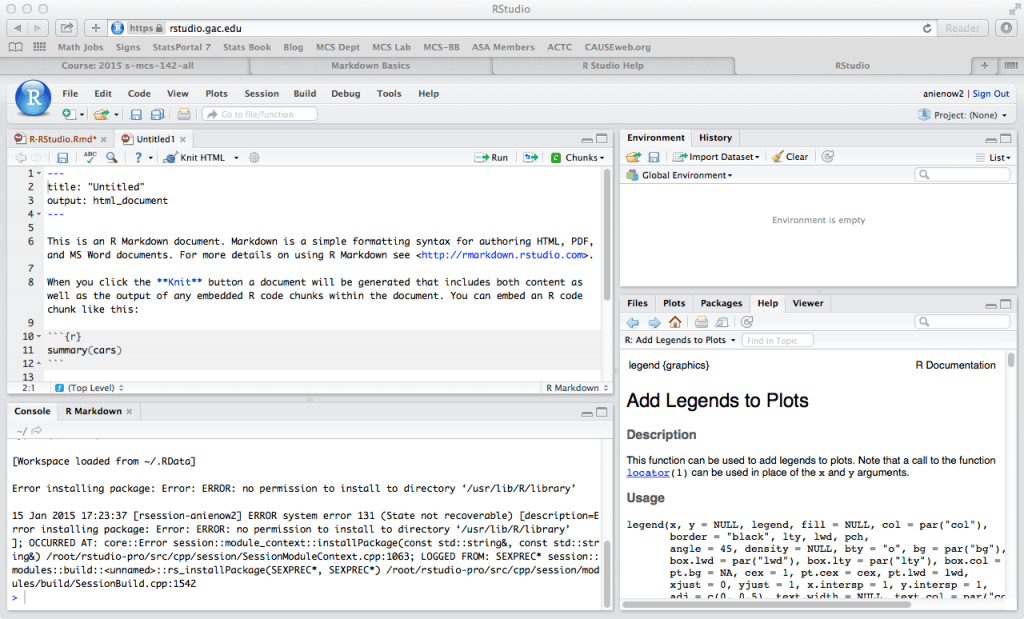R is a programming language. To use R, we need to install an Integrated Development Environment (IDE). Rstudio is the Best IDE available as it is user-friendly, open-source and is part of the Anaconda platform.
RStudio is an open source integrated development environment (IDE) for creating and running R code. It’s available in versions for Windows, Mac, and Linux. Although you don’t need an IDE in order to work with R, RStudio makes life a lot easier.
In this tutorial, we will learn
Install Anaconda
What is Anaconda?
Anaconda free open source is distributing both Python and R programming language. Anaconda is widely used in the scientific community and data scientist to carry out Machine Learning project or data analysis.
Why use Anaconda?
Anaconda will help you to manage all the libraries required for Python, or R. Anaconda will install all the required libraries and IDE into one single folder to simplify package management. Otherwise, you would need to install them separately.
Mac User
Step 1) Go to https://www.anaconda.com/download/ and Download Anaconda for Python 3.6 for your OS.
By default, Chrome selects the downloading page of your system. In this tutorial, installation is done for Mac. If you run on Windows or Linux, download Anaconda 5.1 for Windows installer or Anaconda 5.1 for Linux installer.
Step 2) You are now ready to install Anaconda. Double-click on the downloaded file to begin the installation. It is .dmg for mac and .exe for windows.You will be asked to confirm the installation. Click Continue button.
You are redirected to the Anaconda3 Installer.
Step 3) Next window displays the ReadMe. After you are done reading the document, click Continue
Step 4) This window shows the Anaconda End User License Agreement. Click Continue to agree.
Step 5) You are prompted to agree, click Agree to go to the next step.
Step 6) Click Change Install Location to set the location of Anaconda. By default, Anaconda is installed in the user environment: Users/YOURNAME/.
Select the destination by clicking on Install for me only. It means Anaconda will be accessible only to this user.
Step 7) You can install Anaconda now. Click Install to proceed. Anaconda takes around 2.5 GB on your hard drive.
A message box is prompt. You need to confirm by typing your password. Hit Install Software
The installation may take sometimes. It depends on your machine.
Step 8) Anaconda asks you if you want to install Microsoft VSCode. You can ignore it and hit Continue
Step 9) The installation is completed. You can close the window.
You are asked if you want to move 'Anaconda3' installer to the Trash. Click Move to Trash
You are done with the installation of Anaconda on a macOS system
Windows User
Step 1) Open the downloaded exe and click Next
Step 2) Accept the License Agreement
Step 3) Select Just Me and click Next
Step 4) Select Destination Folder and Click Next
Step 5) Click Install in next Screen
Step 6) Installation will begin
Once done, Anaconda will be installed.
Rstudio Download For Windows
Install R
Mac users
Step 1) Anaconda uses the terminal to install libraries. The terminal is a quick way to install libraries. We need to be sure to point the installation toward the right path. In our case, we set the location of Anaconda to the Users/USERNAME/. We can confirm this by checking anaconda3 folder.

Open Computer and select Users, USERNAME and anaconda3. It confirms that we installed Anaconda on the right path. Now, let's see how macOS write the path. Right-click, and then Get Info
Select the path Where and click Copy
Step 2) For Mac user:
- The shortest way is to use the Spotlight Search and write terminal.
The terminal sets the default working directory to Users/USERNAME. As you can see in the figure below, the path of anaconda3 and the working directory are identical. In macOS, the latest folder is shown before the $. For me, it is Thomas. The terminal will install all the libraries in this working directory.
Latest Version Rstudio
If the path on the text editor does not match the working directory, you can change it by writing cd PATH in the terminal. PATH is the path you pasted in the text editor. Don't forget to wrap the PATH with 'PATH'. This action will change the working directory to PATH.
Step 4) We are ready to install R. I recommend you to install all packages and dependencies with the conda command in the terminal.
r-essentials means conda will install R and all the necessary libraries used by data scientist.
Conda is downloading the libraries
It takes some time to upload all the libraries. Be patient...you are all set.
In the terminal, you should see Executing transaction: done. If so, you have successfully installed R.
You can check where R is located.
Windows User
Step 1) Open the Anaconda command prompt
Step 2) In the command prompt
- Enter the R install command
- Environment will be determined
- List of packages to be installed will be listed
Step 3) Enter y and hit the return key to start installation
Step 4) Installation will take time, and you will get done message.
Install Rstudio
Mac User
In the terminal, write the following code:
In the terminal, you should see Executing transaction: done. If so, you have successfully installed Rstudio.
You are all set now, congratulation!
Windows User
Step 1) Enter command to install R Studio in the Anaconda prompt
Step 2) You will be shown a list of packages that will be installed. Enter y
Step 3) R Studio will be installed
Warning
Avoid as much as you can to install a library using pip for Python, and R. Conda libraries gather a lot of packages, you don't need to install libraries outside of conda environment.
Run Rstudio
Directly run the command line from the terminal to open Rstudio. You open the terminal and write rstudio. You can also use Desktop Shortcut
Or
A new window will be opened with Rstudio.
Test
Open Rstudio from the terminal and open a script. Write the following command:
- ## In Rstudio summary(cars)
- Click Run
- Check Output
If you can see the summary statistics, it works. You can close Rstudio without saving the files.
Install package
Install package with anaconda is trivial. You go to your favorite browser, type the name of the library followed by anaconda r.
You choose the link that points to anaconda. You copy and paste the library into the terminal.
For instance, we need to install randomForest for the tutorial on random forest; we go https://anaconda.org/r/r-randomforest.
Run conda install -c r r-randomforest --yes from the terminal.
The installation is completed.
Note that Thorough this tutorial, you won't need to install many libraries as the most used libraries came with the r-essential conda library. It includes ggplot for the graph and caret for the machine learning project.
Open a library
To run the R function randomForest(), we need to open the library containing the function. In the Rstudio script, we can write library(randomForest)
Warning: Avoid as much as possible to open unnecessary packages. You might ended up creating conflicts between libraries.
Run R code
We have two ways to run codes in R
- We can run the codes inside the Console. Our data will be stored in the Global Environment but no history is recorded. We won't be able to replicate the results once R is closed. We need to write the codes all over again. This method is not recommended if we want to replicate our save our codes
- Write the code in the script. We can write as many lines of codes as we want. To run the code, we simple select the rows we want to return. Finally, click on run. We can see the output in the Console. We can save our script and open it later. Our results won't we lost.
Warning: In we point the cursor at the second row (i.e., slice_vector[1:5]), the Console displays an error. That's, we didn't run the line number 1.
Similarly, if we point the cursor to an empty row and click on run, R return an empty output.
R is a computer language. It’s a tool for doing the computation and number-crunching that set the stage for statistical analysis and decision-making. RStudio is an open source integrated development environment (IDE) for creating and running R code. It’s available in versions for Windows, Mac, and Linux. Although you don’t need an IDE in order to work with R, RStudio makes life a lot easier.
Download R from the Comprehensive R Archive Network (CRAN). In your browser, type this address if you work in Windows:
cran.r-project.org/bin/windows/base/
Type this one if you work on the Mac:
cran.r-project.org/bin/macosx/
Click the link to download R. This puts the win.exe file in your Windows computer, or the .pkg file in your Mac. In either case, follow the usual installation procedures. When installation is complete, Windows users see an R icon on their desktop, Mac users see it in their Application folder.

Both URLs provides helpful links to FAQs. The Windows-related URL also links to “Installation and other instructions.”
Now for RStudio.
Click the link for the installer for your computer, and again follow the usual installation procedures.
After the RStudio installation is finished, click the RStudio icon to open the window shown.
If you already have an older version of RStudio and you go through this installation procedure, the install updates to the latest version (and you don’t have to uninstall the older version).
R-studio For Mac
The large Console pane on the left runs R code. One way to run R code is to type it directly into the Console pane.
The other two panes provide helpful information as you work with R. The Environment and History pane is in the upper right. The Environment tab keeps track of the things you create (which R calls objects) as you work with R. The History tab tracks R code that you enter.
Get used to the word object. Everything in R is an object.
Download R Studio Free For Mac
The Files, Plots, Packages, and Help tabs are in the pane in the lower right. The Files tab shows files you create. The Plots tab holds graphs you create from your data. The Packages tab shows add-ons (called packages) you downloaded as part of the R installation. Bear in mind that “downloaded” doesn’t mean “ready to use.” To use a package’s capabilities, one more step is necessary, and you’ll want to use packages.
This figure shows the Packages tab. The packages are in either the user library (which you can see in the figure) or the system library (which you have to scroll down to).
The Help tab, shown here, provides links to a wealth of information about R and RStudio.
To tap into the full power of RStudio as an IDE, click the larger of the two icons in the upper right corner of the Console pane. That changes the appearance of RStudio so that it looks like this:
The top of the Console pane relocates to the lower left. The new pane in the upper left is the Scripts pane. You type and edit code in the Scripts pane and press Ctrl+R (Command+Enter on the Mac), and then the code executes in the Console pane.
Ctrl+Enter works just like Ctrl+R. You can also select Code → Run Selected Line(s).